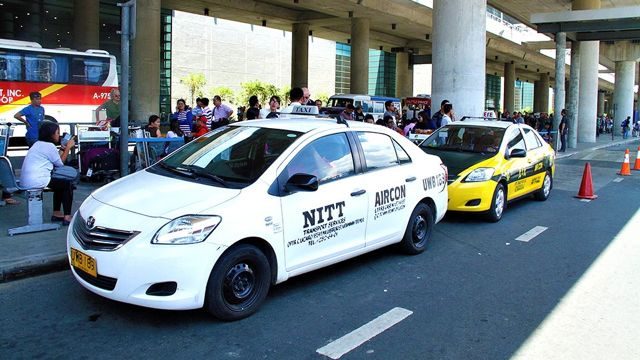SUMMARY
This is AI generated summarization, which may have errors. For context, always refer to the full article.

MANILA, Philippines – A taxi operators’ group on Thursday, August 3, justified cab drivers’ practice of requesting additional fare from passengers.
Lawyer Bong Suntay, president of the Philippine National Taxi Operators Association (PNTOA), told senators that this practice is no different from Uber and Grab’s surge pricing, or the increase in fares based on demand during peak hours.
“[Grab and Uber] are trying to incentivize drivers para kapag traffic, may high demand, pupunta ang auto sa pasahero. Because if they don’t do it, hindi susunduin ng mga sasakyan nila ‘yung mga pasahero,” Suntay said during a Senate public services committee hearing on Thursday.
(Grab and Uber are trying to incentivize drivers so that during heavy traffic and there’s high demand, they would agree to pick up passengers. Because if they don’t do it, the drivers won’t pick up the passengers.)
Suntay explained that some taxi drivers ask for additional payment due to insufficient income or losses incurred in traveling to far or congested areas.
“May taxi driver na magsasabi, ‘Puwede ba padagdag ng P50 sa metro?’ Dahil alam ‘nyo ho, pagka ang pasahero magpapahatid sa lugar na matraffic, malulugi ‘yung driver,” he said.
(There’s a taxi driver who will say: “Can you add P50 to the metered fare?” Because you know, if a passenger wants to be brought to a congested area, the driver would incur losses.)
“If a taxi driver gets stuck in traffic for an hour, the meter would only earn him P75 because our waiting time is P3.50 for every two minutes. A driver who pays a boundary of P1,200 [a day] would need P60 an hour just to make the boundary. This is the reason why taxi drivers ay tumatanggi na maghatid (decline to get passengers),” he added.
Suntay also said he is not “justifying” the act, which has exasperated commuters and prompted them to switch to transport network companies (TNCs) like Uber and Grab.
“I’m not justifying it. I’m just saying the real reason why it’s done,” he said.
Suntay added that the lack of income leads to the negative behavior of drivers.
“As with any normal person, income has a direct connection to individual behavior and action. Kapag walang pera, mas bugnutin ka, mas mabilis kang mainis. Kapag maliit ang kita mo, naghahanap ka ng paraan to augment it (If you don’t have money, you’re more irritable, you’re easily annoyed. If you have limited income, you find ways to augment it),” he said.
Taxi operators have denounced the seemingly undue advantage of Uber and Grab, saying that taxis and TNCs are both engaged in the same business but the latter are not being regulated. (READ: Uber to LTFRB: Don’t impose ancient rules on technological innovations)
They have also slammed the cab flagdown rate in the Philippines, saying it is the lowest in Asia. The group said the last time it was adjusted was in 2009. – Rappler.com
Add a comment
How does this make you feel?
There are no comments yet. Add your comment to start the conversation.